Let’s be honest: most marketers are flying blind. You’re testing new creatives, spending across channels, but still unsure what’s actually working. Sound familiar? Only 61% of marketers feel confident in their strategy, which means the rest are wasting time, budget, or both.
That’s where performance marketing makes the difference. It’s results-first, built for clarity, and focused on what drives growth.
In this blog, we’ll cover:
- What performance marketing really means
- The difference between brand and performance marketing
- Channel breakdowns: paid social, native ads, influencer, affiliate, email & more
- Key metrics to track for results you can actually optimize
- A step-by-step strategy used by top brands
- Tried-and-tested best practices from our agency team
- Real-world brand examples you can learn from and apply today
P.S. Struggling to lower CAC or make your media budget actually perform? inBeat Agency can help you run lean, ROI-driven campaigns powered by high-converting creatives and real-time testing. If you’re tired of wasted spend, we’ve got you. Book a free strategy call now and get clarity on what’s working and what to drop.
TL;DR:
Performance marketing pays only when users take specific actions like clicks, leads, or purchases
It is data-driven and optimized in real time to improve return on investment
Unlike brand marketing, it focuses on direct results rather than long-term perception
Core benefits include lower risk, precise targeting, efficient spending, flexibility, and fast insights
Best suited for DTC, SaaS, e-commerce, and B2B teams focused on lead generation or sales
Primary channels include paid social, search ads, native placements, influencer partnerships, affiliate programs, and email
Critical metrics include CPC, CPM, CPL, CR, CAC, LTV, ROAS, and overall ROI
Strategic setup involves aligning goals with funnel stages and matching channels to customer behavior
Execution relies on clear objectives, smart partner selection, structured testing, and data-informed scaling
Proven tactics include using multi-touch attribution, rotating creatives, managing audience overlap, and optimizing landing speed
Case studies from Unroll.me, CME Group, and Genomelink show measurable performance improvements
Blending with brand efforts improves both short-term performance and long-term equity
Working with inBeat gives access to creative production and performance-driven media buying expertise
What Is Performance Marketing?
Performance marketing is a results-driven approach to digital marketing where brands only pay when a specific action happens, like a click, lead, or sale. Instead of paying upfront for exposure, you pay for real results. That’s what sets it apart from traditional digital marketing campaigns, which often charge for impressions without guaranteed outcomes.
With performance marketing, every dollar works toward a measurable goal, whether it's increasing conversion rates, lowering cost per acquisition, or scaling customer acquisition. It's ROI-driven, trackable, and built for businesses that want results without wasted spend.
As Sergii Denysenko, Forbes Councils Member, puts it:
“A combination of tightening ad budgets, fragmented content consumption and an increasing volume of data has made performance a top priority across campaigns of all sizes and scales.”
Performance Marketing vs Brand Marketing: What’s the Real Difference?
Brand marketing focuses on long-term growth. It builds trust, recognition, and emotional connection over time, like social media presence, content marketing, or brand storytelling. Performance marketing, on the other hand, is all about direct response. You run a campaign, track results in real time, and pay only when someone takes a specific action.
But here’s the thing: the best strategies don’t pick one over the other. You can run performance campaigns that also lift brand awareness.
Read next: Want a deeper breakdown? Check out a detailed guide about: Brand Marketing vs. Performance Marketing: What Should You Pick
Top Benefits of Performance Marketing
So, what makes performance marketing such a smart move for growing businesses? Let’s look at the benefits.
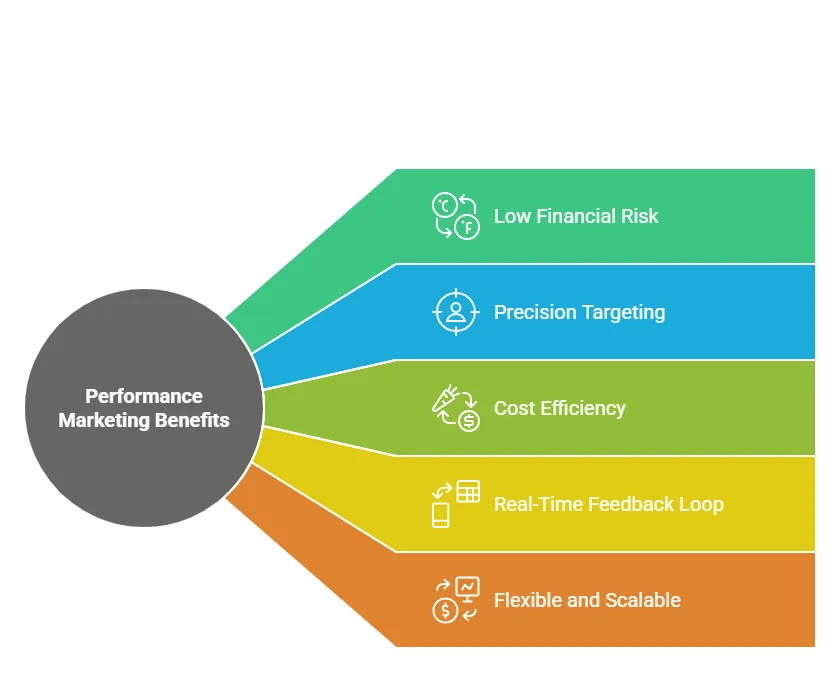
1. Low Financial Risk
Traditional digital advertising often charges you for impressions or views, even if no one clicks. With performance marketing, you only pay when someone takes a specific action, like a click, form fill, or purchase. That means your ad spend goes toward real outcomes instead of passive exposure.
It’s especially important when the average cost per acquisition across industries sits around $53.52. Performance models help keep that spending tied directly to results.
2. Precision Targeting
Performance marketing lets you reach users who are already interested in what you're offering. Instead of wasting spend on broad impressions, you can focus on specific audiences based on search intent, behaviors, or demographics.
In fact, targeted ads generate 2.7× more revenue per ad than general-purpose campaigns and convert at twice the rate.
3. Cost Efficiency
With performance marketing, every part of the campaign is built around efficiency. You can track exactly how much you’re paying to acquire each customer, then adjust your strategy in real time. That means lower cost per acquisition, better return on investment, and fewer wasted clicks on people who were never going to convert.
This level of visibility matters when 40% of marketers say proving ROI is their biggest challenge. Performance marketing solves that bottleneck because you can make sharper decisions backed by real data.
4. Real-Time Feedback Loop
One of the biggest advantages of performance marketing is how quickly you can see what’s working. Platforms like Google Ads and social media dashboards show live data on clicks, conversions, and cost per action. You don’t have to wait weeks to optimize; you can adjust your ad copy, audience targeting, or landing pages while the campaign is still running.
5. Flexible and Scalable
Performance marketing gives you full control over your ad spend and strategy. You can scale campaigns that deliver strong conversion rates or pause the ones that underperform. It's easy to test new creatives, shift targeting, or try different channels without having to rebuild your entire marketing campaign from the ground up.
Who Should Use Performance Marketing?
Performance marketing works across the board, but it shines most for brands that need fast, trackable results. It’s a natural fit for DTC brands, SaaS companies, e-commerce stores, and B2B teams focused on lead generation.
Startups lean on it to get early traction without burning through their budget. Enterprise brands use it to scale across channels while keeping a tight grip on cost per acquisition and ROI.
You can manage performance campaigns with an in-house team or bring in a performance marketing agency to handle media buying, tracking platforms, and channel optimization. The structure works well either way.
Types of Performance Marketing
Performance marketing covers a range of digital advertising tactics built around measurable actions. The goal is the same across all of them: drive results you can track, optimize, and scale, without paying for empty exposure.
Let’s break down the most common types of performance-driven campaigns.
Social Media Advertising
Platforms like Meta, TikTok, and LinkedIn are built for precision. You can target users based on interests, behaviors, job titles, or custom audiences and then measure everything from cost per click to return on investment.
These campaigns are perfect for pushing ad creatives that match where your audience scrolls, especially when you're optimizing for conversion rates and click-through rates across different social media channels.
Slack’s Facebook ad is a great example:
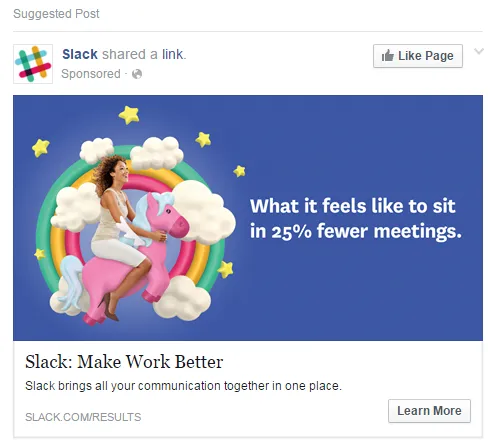
Search Engine Marketing (SEM)
When someone’s already searching for what you offer, SEM puts your brand right in front of them. Using platforms like Google Ads and Bing, you can run pay-per-click campaigns that target keywords your prospective customers are actively typing into search engines.
It’s a proven way to drive action. Google’s search ads alone generate $8 in profit for every $1 spent, which makes them one of the most cost-effective options in digital advertising. With the right ad copy, conversion bid strategies, and solid landing pages, SEM can drive high-quality website traffic and conversions at a lower cost per lead.
Take Snapfish’s Google Ad for example, it shows up right when someone searches “where to print pictures” and offers a direct promo tied to a clear action.
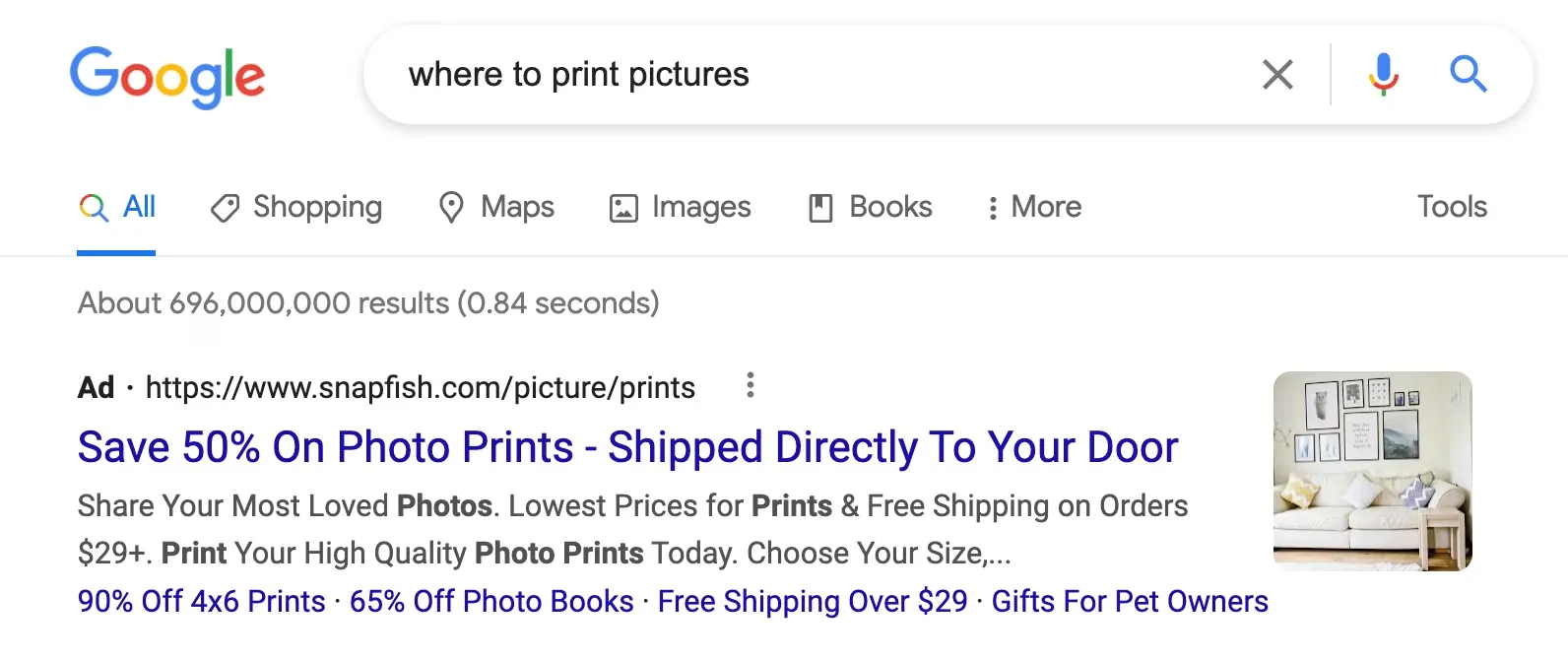
Native & Display Ads
Native ads match the look and feel of the content around them. Platforms like Outbrain and Taboola serve these across news sites, blogs, and mobile apps. In fact, 85% of users say they find native ads more trustworthy than traditional formats, which means they’re a strong option for building credibility.
A strong example is HarperCollins’ sponsored post on BuzzFeed’s Community section.
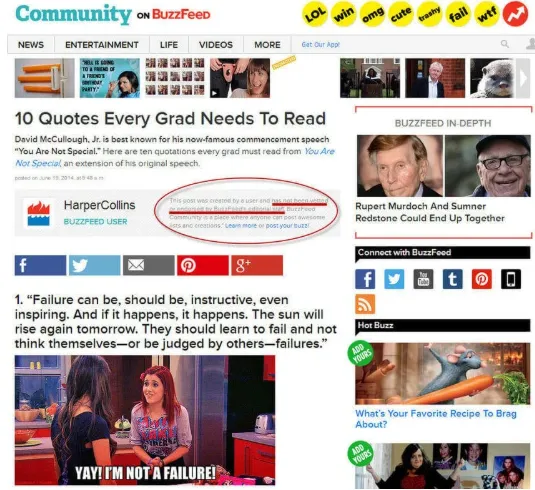
On the other hand, display ads, including banners and visuals, run through programmatic advertising networks. Both formats support brand awareness, retargeting, and drive traffic when paired with strong creatives and smart audience targeting.
Influencer Campaigns
Influencer marketing has evolved into a performance-driven channel. Many brands now partner with creators through pay-per-click or pay-per-conversion deals. Instead of paying upfront for exposure, they reward influencers based on results, like clicks, signups, or purchases. This model works especially well for niche marketing, where loyal audiences are more likely to take action and impact real customer acquisition cost.
A good example is Nurse.com’s partnership with us at inBeat Agency. Their performance-focused influencer campaign strategy led to a 64% drop in cost per acquisition and helped generate over 9,000 qualified leads for continuing education programs.

Affiliate Marketing
Affiliate marketing runs on a simple model: you only pay when someone delivers results. Brands partner with affiliate marketers, bloggers, review sites, or influencers who promote their offers across digital marketing channels. Through an affiliate network, each sale, lead, or credit card transaction is tracked, typically using links or promo codes. It’s a popular tactic for driving low-risk conversions at a set cost per action.
Adidas, for example, runs its affiliate program through Impact, inviting creators to earn a commission by driving traffic and sales through trackable links.
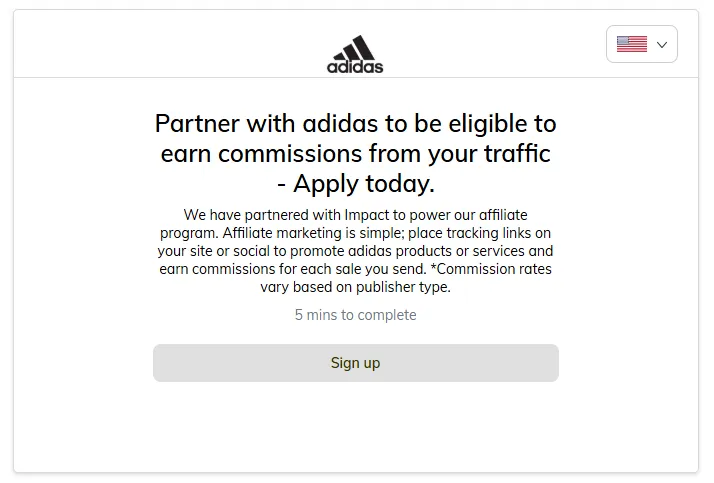
P.S. Curious how affiliate marketing compares to creator-led campaigns? Check out this breakdown on Affiliate Marketing vs Influencer Marketing: What’s the Difference.
Email Marketing
Email still drives serious results, $42 for every $1 spent. This makes it one of the most powerful performance-driven tactics around. You can use newsletter lists, email drops, and automated nurture sequences to deliver targeted offers.
Also, you can measure everything from cost per lead to conversion rate based on how users respond. With clear CTAs, strong copy, and audience segmentation, email becomes a low-cost way to drive high-intent actions across your marketing funnel.
Essential KPIs and Metrics to Track for Performance Marketing
Data is everything in performance marketing. These metrics tell you what’s working, what’s wasting spend, and where to double down. When you're tracking the right signals, it's easier to adjust your marketing strategy, refine your ad copy, and improve results over time.
Some of the essential metrics you should watch are:
- Cost per click (CPC): How much you’re paying for each click. A core metric for Google Ads, social media advertising, and search engine marketing.
- Cost per mille (CPM): The price of 1,000 ad impressions. Still relevant for display ads, media advertising, and upper-funnel visibility.
- Cost per lead (CPL): The cost to generate a new lead through forms, email marketing, or landing pages is crucial, and understanding how to optimize your signup forms can make a significant difference.
- Conversion rate (CR): What percentage of users take the desired action, clicking, signing up, or buying? High-performing landing pages often show this best.
- Customer acquisition cost (CAC/CPA): The total spend it takes to get one customer. This includes ad spend, tools, and advertising programs.
- Lifetime value (LTV): How much revenue a customer brings in over time. Key for balancing CAC and understanding long-term profitability.
- Return on ad spend (ROAS): Revenue generated for every dollar spent on ads. One of the clearest signs your campaign is actually working.
- Marketing ROI: Measures the full return on investment from your entire digital advertising strategy.
How to Build a Winning Performance Marketing Strategy
A winning strategy connects the right audience, message, and timing, backed by real-time data. inBeat experts have broken it down into a clear, actionable framework to help you get started.
Let’s see how to build one.
1. Start With Clear Performance Objectives
Every performance marketing strategy starts with knowing exactly what you want to achieve. Is the goal brand awareness, generating leads, or driving direct sales? Be specific. The clearer your objective, the easier it is to pick the right channel, budget, and message.
Break it down by funnel stage:
Top of funnel (TOFU) performance marketing objectives
Focus on awareness-based targeting. This is where you use CPM pricing models, broad reach campaigns, and display advertising to introduce your brand to new audiences.
For example, our client Hurom uses Instagram ads and creator partnerships to showcase its key product features and build brand awareness.
Middle of funnel (MOFU) performance marketing objectives
At this stage, it’s all about retargeting and lead nurturing. Use email sequences, remarketing ads, and smart audience targeting to re-engage users who already showed interest.
Hurom supports this phase with retargeting ads and educational blog content that spotlight product benefits and build trust with warm audiences.
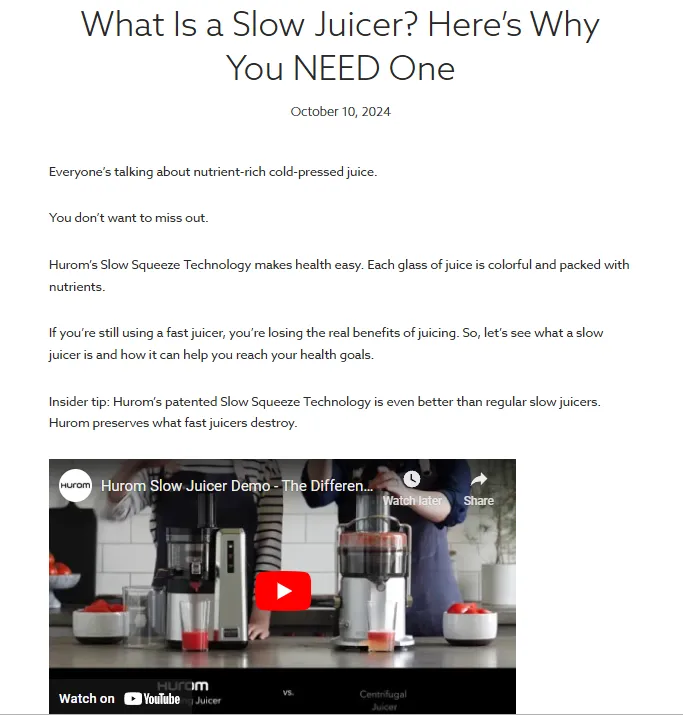
Bottom of funnel (BOFU) performance marketing objectives
Here, you want clicks and conversions. Use sharp ad copy, high-converting landing pages, and clear offers that push users to take a specific action, such as signing up, making a purchase, or starting a free trial.
Hurom uses limited-time discounts and countdown-based campaigns across email, social media, and on-site banners to convert high-intent leads, like its Black Friday promo offering up to $200 off.

2. Pick the Right Channels for Performance Marketing
Your product, price point, and audience behavior should guide where you show up. Choosing a channel based only on the funnel stage can lead to wasted spend.
A skincare brand won’t choose the same channels as a B2B SaaS company, even if both want conversions. This is where strategy beats default thinking.
Ask yourself: Where does your target audience spend time online? What channels align with how your product is researched, discovered, or bought?
For example:
- Visual, impulse-friendly products typically do well on Instagram, TikTok, and influencer campaigns
- Research-heavy or high-ticket offers tend to perform better on Google Ads, native placements, or affiliate blogs
- Subscription models often see strong performance through email marketing, upsell flows, and custom audience retargeting
You don’t need to be everywhere. Start with one or two high-fit channels, run small tests, and expand based on cost per acquisition, conversion rate, and overall return on investment.
Pro tip: We suggest not picking channels solely based on product type. Instead, match them to your buying cycle. Quick, low-cost decisions perform well on social media, while longer sales cycles call for structured touchpoints like SEO or email nurture flows.
3. Identify Your Ideal Performance Marketing Partners
Performance marketing isn’t a solo game. You’ll work with marketing partners, like agencies, affiliate networks, creators, or ad networks, to help you scale efficiently. But not every partner is the right fit.
Start by getting clear on the kind of support you actually need. Do you need a marketing agency to manage strategy and creatives? Or are you looking for affiliate marketers who drive traffic and conversions on commission?
Then look for partners who understand your target audience and target market, work within performance-based models, and have experience with your product or market. The right partner should align with your KPIs, use reliable tracking platforms, and keep communication clear and consistent.
However, if you want results without wasting time or budget, we suggest working with a proven performance marketing agency. They handle media buying, A/B testing, optimization, and day-to-day execution, so you can stay focused on product, growth, and the bigger picture.
P.S. Need help choosing the right agency? This list of the top performance marketing agencies breaks down trusted partners across industries.
4. Launch, Test, and Optimize Your Performance Marketing Campaign
Once your strategy and partners are locked in, it’s time to launch, but don’t hit autopilot. Performance marketing depends on structured testing. Every campaign is a chance to learn what actually drives results.
Start small. Use controlled budgets to test different ad creatives, headlines, landing pages, and offers. Our team at inBeat runs A/B tests, but we avoid changing too many variables at once. We focus on key signals, like click-through rates, cost per acquisition, and conversion rates, to guide what gets scaled or scrapped.
Remember, optimization is a continuous process instead of a one-time task. So, use real-time insights from your tracking platforms to pause what’s underperforming and double down on what’s working.
5. Monitor, Learn, Scale
After testing and refining, the next step is building momentum with a scaling strategy that’s backed by data. Budget shifts should be based on actual performance trends instead of assumptions.
Set weekly or bi-weekly reviews to track what’s delivering value. Go beyond surface metrics. Focus on lifetime value (LTV), customer acquisition cost, and how each channel contributes to long-term profitability. A campaign with slightly higher costs may still perform well if it consistently attracts high-value customers.
These insights help you make smarter media decisions, strengthen what’s performing, and confidently expand into new audiences. That’s how performance marketing drives consistent growth over time.
Performance Marketing Best Practices
At inBeat, we’ve run hundreds of performance campaigns across different industries, budgets, and business goals. These best practices come straight from what we’ve seen work and what we’ve refined through real testing.
If you're looking to scale smarter, these are the habits worth keeping.
- Don’t rely on last-click attribution alone: Last-click tracking often gives credit to the final touchpoint and ignores what actually influenced the user earlier in the funnel. Use multi-touch attribution or tools like Google Analytics 4 to get a fuller view of what’s driving results.
- Refresh creatives before fatigue kicks in: Even top-performing ad creatives burn out. If click-through rates dip or frequency scores climb, rotate visuals and copy before performance drops. Keep a testing calendar to stay ahead of creative fatigue.
- Monitor audience overlap across platforms: Running Meta, TikTok, and Google Ads? Check for duplicate reach. Use tools that help segment by source to avoid bidding against yourself or showing the same ad to users too frequently.
- Build offers around urgency and clarity: The best-performing campaigns sometimes pair strong targeting with a specific, time-sensitive offer. Add countdown timers, limited-time messaging, or fast-action incentives to push conversions without relying on gimmicks.
- Align landing page speed with ad spend: Sending traffic to a slow, unoptimized landing page kills ROI. Use tools like PageSpeed Insights or GTmetrix to ensure fast load times, especially on mobile. Even a 1-second delay can hurt conversion rates.
- Use AI to improve efficiency: AI tools can analyze data faster, automate audience targeting, and suggest bid adjustments. But remember, they still need human oversight. Use AI for what it does best (predictive insights, real-time bidding, ad copy variations), but keep human creativity at the center of messaging, storytelling, and brand voice.
Real-World Performance Marketing Examples
You’ve seen the strategy. Now let’s explore how smart brands are putting it into play, with actual campaigns that drive measurable results.
1. Unroll.me
Unroll.me teamed up with inBeat to drive massive user growth using a creator-led performance strategy. Each month, they partnered with 8+ different influencers and tested over 40 unique creatives to keep content fresh and conversion-focused.
This approach helped them generate more than 7 million app installs across Android and iOS, while lowering CPA by 75% in a highly competitive app space.
It’s a perfect example of how influencer partnerships and paid performance campaigns can work hand-in-hand to scale smartly.
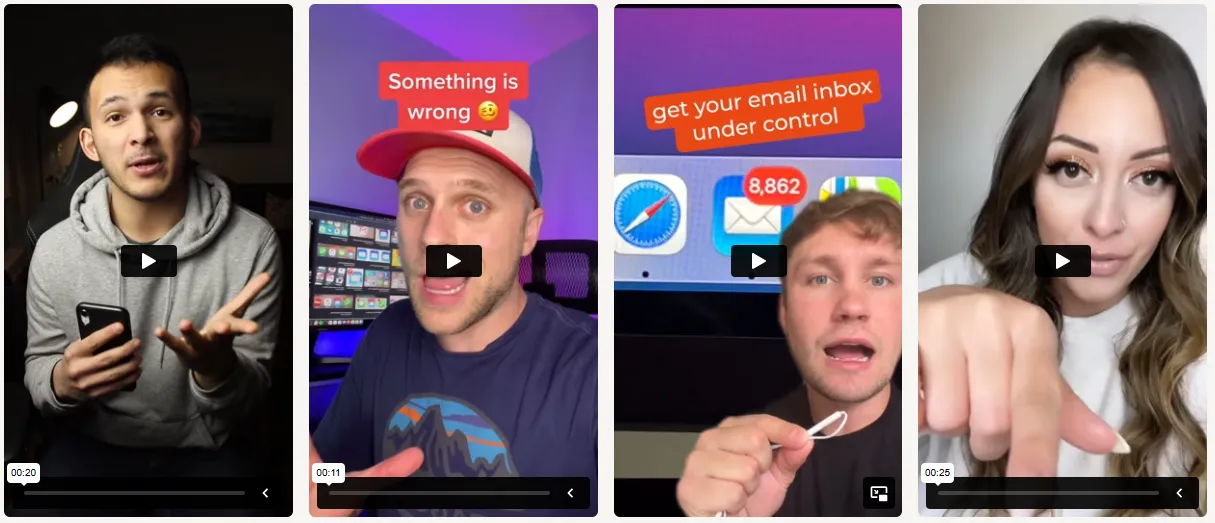
2. CME Group
CME Group ran a sharp display ad on Forbes with a clear message: “Where risk meets opportunity.” The creative spoke directly to financial professionals, pairing bold visuals with a confident CTA. Running this ad on a high-authority platform like Forbes helped elevate their brand presence and capture attention from decision-makers in the finance world.
It’s a strong example of using display ads to build visibility and spark awareness at the top of the funnel.

3. Genomelink
Genomelink teamed up with inBeat to run a performance-driven, omnichannel acquisition strategy, and the results speak for themselves. With 70 unique assets a month and UGC-led creatives across five paid media channels, they consistently hit CAC and ROAS targets.
By mixing UGC, statics, b-rolls, and mashups, they brought their DNA testing service to life in an authentic way. Over time, this smart, creative mix led to a 77% drop in CAC, proof that content variety and channel diversification can seriously move the needle.
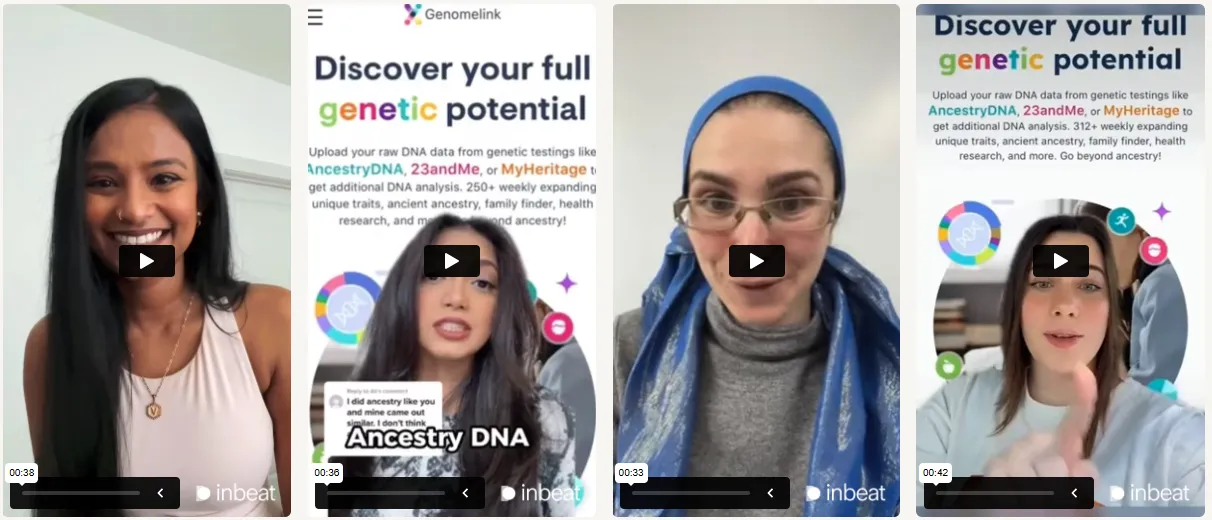
Turn Clicks Into Revenue-Generating Campaigns with inBeat
Performance marketing offers a clear path to sustainable growth. With the right strategy, creative testing, and performance-driven partners, you can build campaigns that consistently deliver real business impact.
Key takeaways
- Performance marketing is built around actions like clicks, leads, and purchases
- Brand and performance efforts work best when integrated with purpose
- Channel choices should reflect how your audience researches and buys
- Continuous testing helps identify what drives the strongest results
- The right partner brings strategy, tools, and efficient execution
- Data-backed insights lead to better decisions across campaigns
- Frequent reviews help refine performance and improve customer value
- AI tools enhance targeting and analysis when guided by a smart strategy
If you want to launch performance campaigns that actually drive revenue, inBeat Agency is here to support you. We blend creative production with strategic media buying to help brands grow with clarity.
Book your free strategy call today and start building smarter.
FAQs
What are the basics of performance marketing?
Performance marketing focuses on measurable results, clicks, sign-ups, or purchases. You only pay when someone takes action. It’s data-driven, optimized in real time, and designed to scale efficiently.
What is a KPI in performance marketing?
A KPI, or Key Performance Indicator, is a metric that helps track how well your campaign performs. Common KPIs include cost per click, conversion rate, ROAS, and customer acquisition cost.
What are the 8 P's of marketing performance?
The 8 P’s include: Product, Price, Place, Promotion, People, Process, Physical Evidence, and Performance. These guide both traditional and digital marketing to drive measurable results.
What makes performance marketing different from traditional advertising?
Traditional ads charge for visibility. Performance marketing charges for outcomes. Instead of paying for impressions, you pay when someone clicks, signs up, or buys, so you know where your money goes.
Can you combine performance and brand marketing?
Yes. Many top brands use performance campaigns to drive results while also lifting brand visibility. When done well, both work together to grow short-term revenue and long-term equity.
How do performance marketers track conversions?
Yes. Many top brands use performance campaigns to drive results while also lifting brand visibility. When done well, both work together to grow short-term revenue and long-term equity.
Is performance marketing SEO?
No, performance marketing and SEO are different. SEO focuses on driving organic traffic over time, while performance marketing involves paid campaigns where you only pay when users take specific actions like clicking or converting.

